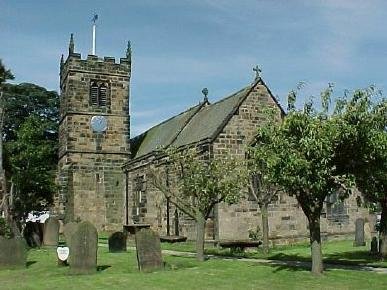
| Brief History of Brompton Churches | The Tower |
|---|---|
| The Saxon Crosses | The Cock Shaft |
| The Wheel Head Crosses | The Hogback Stones |
| Early Developments | John Kettlewell and Restoration |
 |
 |
The Methodist Church and St. Thomas' Church,
|
||||
|---|---|---|---|---|
| Home | St Thomas' Information |
How to find the churches |
Methodist Information |
Songs of Praise at The Orchards |
| Mothers & Others | Sunday School |
Youth Fellowship (B.E.Y.F.) |
Brompton Fellowship | Mothers' Union |
| Photographs |
Events and Service Times |
- | - | Links to others in Brompton |
|
||||
In the 14th century the chancel was rebuilt, partly on old foundations, being now 22 feet long
by 16 feet wide. At the same time, the nave was extended westwards by 12 feet. On the window
sills of the north aisle can be seen simple grave slabs from this period. The tower, which also
serves as a porch, was added to the south side of the church in the 15th century.
The Reformation brought many changes in religion, the most notable being the adoption of services
in the vernacular as laid down in the Book of Common Prayer. Yorkshire adopted these changes very
slowly being loath to relinquish the tried and tested patterns of worship, as was shown by the
county’s involvement in the Pilgrimage of Grace (1536) and the Rising of the North (1569).
John Fisher, Bishop of Rochester who was executed in 1535 for refusing to acknowledge the
Royal Supremacy, had been Vicar of Northallerton from 1491 to 1494. Despite these rebellious acts,
during the reign of Elizabeth 1 the Anglican form of service was in general use and the
Parish Register for Saint Thomas’, Brompton begins in this period in 1594, as a separate register,
despite its close ties with Northallerton.
Early Developments
Despite continued disruptions during Norman times and the early Middle Ages, the church in Brompton
began to take in its present physical form. The original structure consisted of a narrow
rectangular nave about 45 feet long and 15 feet wide, with a small, square chancel attached
to the East end. There was no tower. In 1180, the north aisle was added, being 45 feet
long by 9 feet wide. This was separated from the body of the nave by an arcade of four bays and
three columns, the centre one of which is octagonal, the other two are round. There is no carving on the
columns and the capitals are simply treated, except for that nearest the chancel, which has
a waterleaf design.

| Brief History of Brompton Churches | The Tower |
|---|---|
| The Saxon Crosses | The Cock Shaft |
| The Wheel Head Crosses | The Hogback Stones |
| Early Developments | John Kettlewell and Restoration |
 |
 |